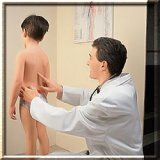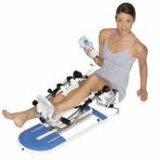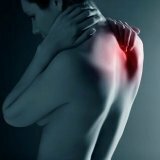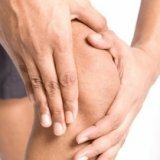Children's diseases of the spine

Now more and more children have diseases of the musculoskeletal system, including diseases of the spine. Such diseases include arthrosis, curvature of the spine( scoliosis), osteochondrosis, arthritis and others. Children spine disease is often associated with metabolic disorders, addictions, who are trying to have children in a small age, disharmonic diet and unhealthy lifestyle( sports ignoring long pastime at the computer and game consoles).
By kyphosis is called the curvature of the spine, which occurred in the sagittal plane by convexity from behind. There are different types of kyphosis: lumbar, lower thoracic, upper thoracic, total.
Congenital kyphosis occurs: it is located in the thoracic and upper lumbar region. Identify the deformation can be early, as soon as the child begins to sit. Over time, with the growth of the baby, the deformity increases significantly, with no neurologic symptoms observed, pain in the child also does not happen. At the time of puberty, the deformation becomes pronounced, and the growth of the child is delayed.
Kyphosis, which is acquired over time, can be the result of osteochondropathy, rickets, compression fractures of vertebral bodies.
Kyphosis as a result of rickets is caused by a general muscle hypotension( with severe rickets).It develops rapidly and characteristic is the curvature of the lumbar and lower thoracic parts.
There is another kind of curvature of the spine - lordosis. The curvature occurs in the sagittal plane by convexity forward. Physiological lordosis of the lumbar and cervical spine is the result of the formation of the vertical position of a person. Excessive or pathological lordosis is usually localized in the lumbar spine and may be associated with pathological changes in the lumbar vertebrae and the tissues surrounding them, thus it can be both acquired and innate nature( wedge-shaped vertebrae, spontaneous spondylolisthesis et al.).
Congenital lordosis in adolescent children, if the disease is hidden, can manifest as a pain in the lower back and rapid fatigue. If the child has compensatory lordosis, then it most likely runs without symptoms.
The most common type of deformity in children is scoliosis. Under scoliosis mean curvature of the spine that has occurred in a frontal plane, which is caused by pathological changes in the spine and paravertebral tissue prone to deformation with an increase in static-dynamic irregularities and irregularities in the internal organs. Scoliosis can be both congenital and acquired.
If congenital scoliosis, its origin is due to abnormalities of the spine and ribs( extra ribs, wedge, additional hemivertebrae and vertebrae, the spinous processes synostosis), dysplasia lumbar-spine krettsovogo, which defines the term "dysplastic scoliosis."
Acquired scoliosis is usually expressed as symptoms of other diseases. Static scoliosis commonly found in people with shortened lower limbs, contractures of the hip and knee joints, unilateral congenital hip dislocation. Neurogenic and myopathic scoliosis formed due to imbalance of the back muscles, with syringomyelia, rickets, neurofibromatosis, deforming muscular dystonia. There are scoliosis caused by post-burn scars of the trunk, diseases and operations of the chest or cavity. In addition, the cause of scoliosis can be a tumor of the spine and paravertebral localization, metabolic disorders.



